
Air Force Report : Iraqi Air Force & Army Air Corps
This page was last updated in early 2007. Since then the formation of the air force and the air corps has seen many new plans, equipment, and facilities, plus several changes. For example, T-6 trainers and EC635 helicopters entered service, F-16 fighters and L-159B jet trainers have now been ordered. For more information visit DJ Elliott's blog, for Iraqi military development and status updates and his well-maintained Iraqi Order of Battle. In both sections, between the Army and Police information, you'll find the latest updates on the current and planned aircraft, units, and airbases for the Iraq's air arms.
(New) Iraqi Air Force (IqAF) and Iraqi Army Air Corps
May 2007
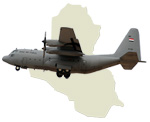
Introduction
After the US-led invasion of Iraq in 2003, it became evident that Iraq would need
to rebuild its air force from scratch. In April 2004, the Coalition Provisional
Authority (CPA) announced that the first steps to form a New Iraqi Air Force were taken. The
new Iraqi Air Force is required to carry out border patrol and aerial surveillance. Especially
a capability in the latter role is needed to secure Iraq's network of oil piping.
Iraq is also required to build up its transport capability of both cargo and personnel, including
VIPs.
At the same time, the Iraqi Army is being reformed. At this time, it is believed that the
Iraqi Army will have its own air component. For ease, we will report about the aircraft
and helicopters for both services in this report.
On September 7, 2006, operational control of the Iraqi Air Force, Navy and ground forces was
officially transferred to the Iraqi government. Army, Air Force and Navy are all commanded
from the joint headquarters in Baghdad now. It is anticipated that the Iraqi Air Force
will grow to a strength of almost 2,500 personnel by the end of 2007.
Light Aircraft: Seeker SB7L-360
The first aircraft to enter service with the newly formed Iraqi Air Force, were two Seeker SB7L-360 light surveillance aircraft. The contract was awarded after an accelerated tender in June 2004 to Seabird Aviation Jordan, a joint venture between Jordan's King Abdullah II Design and Development Bureau and Seabird Aviation Australia. The contract worth 2.3 million USD included training, maintenance and support. The Seabird Seekers were handed over on 29 July 2004 and airlifted by a USAF C-130H to Basrah Air Base on 18 August 2004. The aircraft carry a sand-colored camoflage, the Iraqi flag on the fin, and serials YI-101 and YI-102. 70 Squadron was formed at Basrah to operate the aircraft.
Light Aircraft: SAMA CH2000-MTA
Although initially believed to be destined for Seabird, the follow up order for more light utility aircraft was awarded to a US company offering the SAMA CH2000. The aircraft are assembled by Jordan Aerospace Industries in Amman. The aircraft is based on the Canadian design of the Zenair Zenith 2000. The CH2000-MTSA (Military Tactical Surveillance Aircraft) version is a two-seat surveillance and training aircraft fitted with an Ultra 8500FW Gyro stabilized optical-electronic system with cooled IR Thermal imaging and daytime TV camera capable of detecting a man-sized target at 3-3.5km range from 2,000ft. The contract for eight CH2000s with an option for eight more aircraft. Initially all eight aircraft of the first batch were to be delivered by March 2005. Although the first two examples (YI-103 YI-104) were delivered on 18 January 2005, the remaining six aircraft were rescheduled to be delivered later. On January 6, 2007, Jordan Aerospace Industries announced that it had delivered the final two aircraft. All eight aircraft of the first batch were originally planned to enter service with 70 Squadron at Basrah Air Base, with the second batch going to 2 Squadron at Kirkuk AB, if the option was exercised. However aircraft of the first batch are now operated by 70 Squadron as well as 3 Squadron. The CH2000 fleet has now logged 1,300 flight hours in Iraq. The fleet is maintained and supported by a team of JAI logistic and technical staff at Kirkuk AB, JAI also trains Iraqi technicians.
Light Aircraft: Comp Air 7SLX
The United Arab Emirates (UAE) donated four Aerocomp Comp Air 7SL turboprop light aircraft, quickly
followed by an additional batch of three. Although it now seems only six were taken on strength,
and the actual type being the 7SLX.
The first batch of the 6-seat aircraft was delivered on 13 November 2004 and are equipped with a recce sensor suite.
But it is believed they will be operated primarily in the utility role, because of its larger
passenger capacity as well as oil pipeline surveillance. They equip 3 Squadron and will be joined later by the ex-UAEAF Bell 206B
helicopters (see helicopter section).
3 Squadrons was declared operational on 10 April 2005, after graduation from basic training by
the initial six pilots and eight maintenance engineers.
Unfortunately one Iraqi Air Force Comp Air 7SLX was lost in a fatal crash
during an operational mission from Kirkuk Air Base on 30 May 2005. Four U.S. servicemen and
one Iraqi airman died when it crashed near Jalula, about 50 miles northeast of Baquba, Iraq.
This was the first loss of an aircraft since the re-equipment of the Iraqi Air Force. Five Comp
Air were reported to remain in service.
Following the crash, a USAF team undertook initital flight tests of the type in October 2005, after
being declared unsafe to fly the fleet was grounded in January 2006. Due to modification work the
aircraft flying qualities had degraded. One aircraft, serialled 2240, was shipped to the US for a complete rebuild.
It flew again at Edwards AFB on April 25, 2006. The remaining four aircraft were planned to be rebuilt
at Kirkuk AB starting in May 2006.
Light aircraft: King Air 350ER
In September 2006, the US Defense Security Co-operation Agency (DSCA) announced a possible FMS
deal for Raytheon's King Air 350ERs and stated eventual requirement totalled 24 King Air
350ER intelligence, surveillance and reconnaissance (ISR) aircraft and a further 24 King Air 350ER
light transport aircraft (LTA), with the M-28 Skytruck considered as alternative for the latter.
On January 3, 2007, the US DOD announced a $132.3 million FMS contract had been signed with Raytheon for five King Air
350ER ISR aircraft and one King Air 350ER LTA for the Iraqi Air Force. The 350ER is a derivative of
the King Air 350 with additional fuel tanks offering extended range. The ISR version will be fitted
with a synthetic aperture radar (to be selected), datalink and L-3 Wescam MX-15 electro-optical/infra-red
system. Both ISR and LTA variants for the Iraqi Air Force will be fitted with AN/AAR-47 and AN/ALE-47
self protection systems.
Transports: C-130
Jordan has donated two C-130B Hercules tactical transport aircraft. The aircraft were formerly
in service with the Royal Jordanian Air Force (RJAF) but were put into storage in the early 1990s.
Prior to delivery, they will be fully overhauled. It seems they are still not delivered.
The CPA announced in April 2004 a requirement
of a total of six C-130 Hercules aircraft. Three ex-USAF C-130E Hercules aircraft were handed over
in January 2005 by the United States. Prior to delivery the aircraft had been overhauled and
although still in USAF transport colors it carries Iraqi Air Force titles and the Iraqi flag on the tail.
The C-130 fleet is operated
by 23rd Iraqi Transport Squadron from New Al Muthana Air Base in Baghdad.
The 23rd Iraqi Transport Squadron was originally activated on July 14, 1965,
at Al Rasheed Air Base. Its primary mission was and will continue to be
transporting military personnel and equipment. About 65 Iraqi Air Force
personnel, including four crews, have completed a four-month lead-in course
in Jordan and were trained at Tallil Air Base (renamed Ali in mid-2005) in Iraq
by the 23rd Advisory Support Team, an element of the 777th Expeditionary Airlift
Squadron from Little Rock AFB, Arkanses, to fly and maintain the new airplanes.
On January 31, 2006, the squadron moved to its current location of
New Al Muthana Air Base in Baghdad, the reconstructed air base was officially
reopened on March 7, 2006.
Helicopters: Bell UH-1H Huey II
Jordan donated 16 ex-RJAF UH-1H utility helicopters. The helicopters are overhauled prior to delivery,
the last aircraft to be expected for delivery in February 2006. The first two examples were
delivered on 1 February 2005 arriving at Taji Air Base.
Reportedly the first 14 of 48 pilots have completed training and four UH-1Hs have been delivered by now,
although earlier it was reported six were already delivered.
The UH-1Hs will operated from Taji AB in two squadrons, believed to be 2 and 4 Squadron.
A report in Stars and Stripes on 3 December 2005 revealed that all 16 UH-1H helicopters
are planned to be upgraded to Huey II standard to better cope with the demanding operational
environment. The contract was awarded to US Helicopters Inc. In September 2006, it was reported that
the Huey II upgrade was underway at its facility at Ozak, Alabama, and
the first upgraded helicopters would be re-delivered in January 2007. This became February 2007,
when the first batch of five refurbished UH-1Hs upgraded to Huey II standard were delivered.
Two were at a formal hand-over ceremony in Baghdad on March 3 to be officially accepted by
Iraq's Defence Minister, General Abdel Qadar Jassim ai-Ubeidi.
Helicopters: Bell 206B JetRanger
The UAE donated four Bell 206B JetRanger helicopters in December 2004, but delivery was delayed until May/June 2005. They arrived at Baghdad International Airport retaining their UAEAF colors with the markings removed. They will be operated by 3 Squadron based at New Al Muthana, West Badghdad International Airport Air Base. Some reports indicate a total of five JetRangers.
Helicopters: PZL Swidnik W-3 Sokol
On 15 December 2004, the new Iraqi Ministry of Defence signed two contracts for more helicopters
with Polish state-owned defence industry consortium BUMAR. The first contract worth about 132 million
USD covered 20 PZL Swidnik W-3 Sokol helicopters. The helicopters were destined for the Iraqi Army
and would have been delivered in November 2005. The order consisted of four VIP configured, four MEDEVAC
configured and twelve armed assault helicopters. The contract included the training of ten
Iraqi pilots and 24 maintenance and technical personnel. However BUMAR announced in mid April 2005
that the contract will not proceed as planned. It is believed that the delivery schedule
proposed by PZL Swidnik was not acceptable. For the time being, only two W-3A Sokols were planned to
be delivered in 2005 for testing. However most recent news reported them almost being ready for delivery
in June 2006.
The Polish Deputy Defence Minister stated that some of the equipment used by the Polish troops currently
deployed in Iraq, may stay in the country for the new Iraqi armed forces. This equipment will probably
include some W-3 helicopters. Also a new order for a number of Sokols was expected, exceeding the initial
figure of 20. However since then, Iraq has been ordering more new-built Mi-17s.
Helicopters: Mil Mi-17 'Hips'
The second contract with Poland worth 105 million USD included among other equipment the delivery of 24 Mil Mi-17
medium transport helicopters. BUMAR would deliver reworked second-hand Mi-17 aircraft. Air Forces Monthly
published a photo of one of five Mi-17s being prepared for delivery at the Spark rework
facility at Pulkovo Airport, St. Petersburg, Russia. All five were painted in a three-tone green/redbrown/desert
camouflage scheme, and would be delivered to Iraq airfreighted by Il-76 or An-124 when rework was completed.
However the helicopters were rejected because they were allegedly not up to specification.
A second deal was signed for 10 new-built Mi-17s in 2005. On February 14, 2006, the first four Mi-17s arrived
in Iraq, followed by a second batch of four Mi-17s
delivered onboard an An-124 on February 17. One of these eight was reported to be a VIP configured
Mi-171. Two Mi-17s were delivered later in 2006.
In September 2006, USAF Brig-Gen Stephen L Hoog commander of the Coalition Air Force Transition Team
revealed that the 10 Mi-17 helicopters were to enter service soon, with the training of Iraqi pilots already
underway. In the same month, it was announced that Iraq was 20 Mi-17 helicopters as
part as a larger FMS sale. In 2007 it was revealed that 28 new Mi-17 helicopters had been ordered
thru BUMAR in a new contract replacing the previous contracts for 24 second-hand
and 10 new helicopters.
The first Mi-17s are now operating from Taji air base, 24km north of Baghdad. They are
primarily used for local training flights, because the helicopters lack
self-defence systems required to safely perform combat missions.
The rest of the 28 Mi-17s should enter service in 2007. Iraqi Defence Minister General Abdel Qadar
Jassim ai-Ubeidi noted in March 2007, that the Iraqi Air Force should have between 50
and 60 helicopters in service by the end of 2007.
Training
For training of Iraqi Air Force aircrews and personnel, the commander of the Iraqi Air Force has requested support from the Polish Air Force. The Polish Air Force Academy at Deblin was assessed by the Iraqi Air Force and fully meets the requirement. The long-term cooperation includes training for fast jet pilots, helicopter and transport aircraft crews, air traffic controllers, ground intercept controllers and technicians. All training will start with an six-month English course, general military training and physical training.
Sources & Resources:
- Air Forces Monthly 2007 - Mar, Apr, May
- Air Forces Monthly 2006 - Feb, July, Sep, Oct, Nov
- Air Forces Monthly 2005 - Jan, Feb, June, July, Sep
- Air Forces Monthly 2004 - Aug, Sep, Oct, Nov, Dec
- Scramble
- US Department of Defense
- USAF: Iraq Newslink
- Portal Iraq
- DefendAmerica: Iraqi Pilots Fly Prime Minister for First C-130 Mission
- Jordan Aerospace Industries
- Cook, Capt Russ (2006), Iraqi Air Force gets Mi-17 'Hip' helicopters, MNSTC-I Coalition Air Force Transition Team
Serials (confirmed & unconfirmed)
Seeker SB7L-360 (2/2 in service)
- YI-101, ex JY-SEA
- YI-102,
SAMA CH2000 (8/8 in service)
- YI-103
- YI-104
- ???, ex JY-MD6
- ???, ex JY-MD7
-
-
-
-
Comp Air 7SLX (5/6 in service, one lost)
- 2240
-
-
-
-
-
UH-1H Huey II (5/16 in service)
- YI-201, ex RJAF
- YI-202, ex RJAF
- YI-203, c/n 11583, ex RJAF 827 (unconfirmed)
- YI-204, ex RJAF
- YI-205, ex RJAF
- YI-206, ex RJAF
- YI-207, ex RJAF
- YI-208, ex RJAF
C-130E (3/3 in service)
- YI-301, c/n 382-3802, ex 62-1839
- YI-302, c/n 382-3790, ex 62-1826
- YI-303, c/n 382-3903, ex 63-7826
Bell 206B (4/4 or 5/5 in service)
- ???, ex UAEAF 171
-
-
-
-
C-130B (2 donated, not delivered)
- ???, ex RJAF 341
- ???, ex RJAF 340
Mi-17 (10/28 delivered, 4 in service)
-
-
-
-
-
-
-
-
-
-
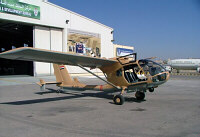
Seabird Seeker
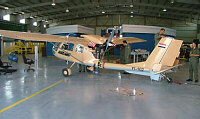
Seabird Seeker
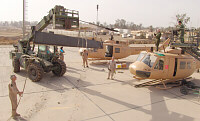
UH-1H reassembly after arrival

Ex-USAF C-130E

Comp Air 7SL delivered in Nov 2004

Ex-USAF C-130E
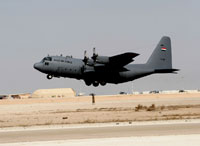
Ex-USAF C-130E
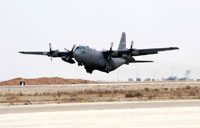
Ex-USAF C-130E
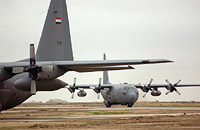
Two Iraqi C-130E taxiing

CH2000 YI-104 over its base at Basrah
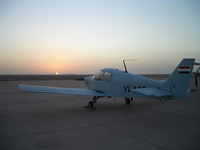
SAMA CH2000 YI-103
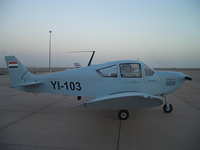
SAMA CH2000 YI-103
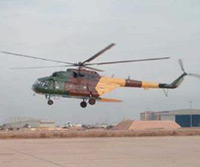
New Iraqi Mi-17 Hip
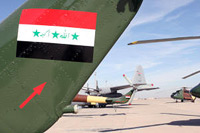
Mi-17s and C-130E at new Al Muthana AB
Last revised: 1 May 2007
Last modified: 25 January 2016
Update log:
25 Jan 2016 Moved & upgraded layout
11 Feb 2013 Out-of-date notice
01 May 2007 Updated
 Back to Index
Back to Index